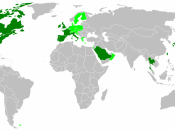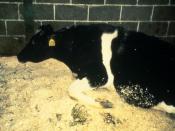Bovine spongiform encephalopathy (BSE) is a relatively new disease found primarily in cattle. This disease of the bovine breed was first seen in the United Kingdom in November 1986 by histopathological examination of affected brains (Kimberlin, 1993) . From the first discovery in 1986 to 1990 this disease developed into a large-scale epidemic in most of the United Kingdom, with very serious economic consequences (Moore, 1996).
BSE primarily occurs in adult cattle of both male and female genders. The most common age at which cows may be affected is between the ages of four and five (Blowey, 1991). Due to the fact that BSE is a neurological disease, it is characterized by many distinct symptoms: changes in mental state 'mad-cow', abnormalities of posture, movement, and sensation (Hunter, 1993). The duration of the clinical disease varies with each case, but most commonly lasts for several weeks. BSE continues to progress and is usually considered fatal (Blowey, 1991).
After extensive research, the pathology of BSE was finally determined. Microscopic lesions in the central nervous system that consist of a bilaterally symmetrical, non-inflammatory vacuolation of neuronal perikarya and grey-matter neuropil was the scientists' overall conclusion (Stadthalle, 1993). These lesions are consistent with the diseases of the more common scrapie family. Without further investigation, the conclusion was made that BSE was a new member of the scrapie family (Westgarth, 1994).
Transmission of BSE is rather common throughout the cattle industry. After the incubation period of one to two years, experimental transmission was found possible by the injection of brain homogenates from clinical cases (Swanson, 1990). This only confirmed that BSE is caused by a scrapie-like infectious agent.
How does the transmission become so readily available among the entire United Kingdom feedlot population? Studies showed that the mode of infection was meat and...



Mad cow disease
needs a work cited page
2 out of 2 people found this comment useful.